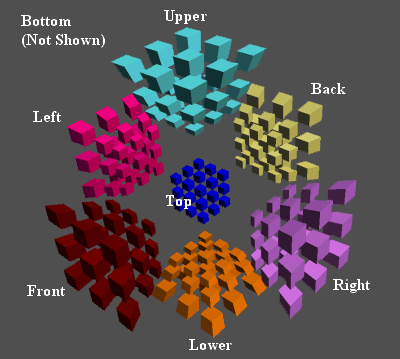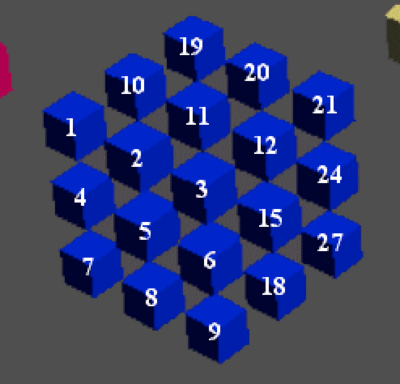Difference between revisions of "Notation"
| Line 22: | Line 22: | ||
If you wanted to make the F face of the T cell become the U face of the T cell, that would be Tx because it's rotating the T cell clockwise along the x axis. <br> | If you wanted to make the F face of the T cell become the U face of the T cell, that would be Tx because it's rotating the T cell clockwise along the x axis. <br> | ||
One of the downsides of this notation is that edge and corner twist moves become longer. For example: T[UF] becomes Tz2x. <br> | One of the downsides of this notation is that edge and corner twist moves become longer. For example: T[UF] becomes Tz2x. <br> | ||
| + | |||
| + | '''Rotation Notation V2:'''<br> | ||
| + | Rotating around an axis is actually just a trope of living in 3 dimensions. It is much more helpful to think about rotations as happening in a 2-dimensional plane rather than around a 1-dimensional axis. This idea became the basis for Rotation Notation V2. <br> | ||
| + | In 3d, the rotations are x, y, and z. You can think about these rotations being called this because they are not in the plane. For example, a y rotation is rotating a 3x3x3 within the xz plane, so it is called y. And y is closer in the alphabet to U than it is to D, so a y rotation goes the same way as a U rotation, except to all 3 layers. <br> | ||
| + | The same exact logic works in 4d, but this time you have to list the 2 axes that the plane of rotation doesn't involve. For example, doing an RK move would be Rxw because an RK rotates the R cell within the yz plane. And it would go the same direction as R because x is closer in the alphabet to R than L. | ||
===Experimental Notations:=== | ===Experimental Notations:=== | ||
| − | ''' | + | '''Symmetry Notation:''' <br> |
Blob Notation was an attempt by Blobinati Cuber to make Zhao Notation more efficient by making each of the 13 symmetries of a cube into a letter (a-m) following the main 8 letters that represent the cells. <br> | Blob Notation was an attempt by Blobinati Cuber to make Zhao Notation more efficient by making each of the 13 symmetries of a cube into a letter (a-m) following the main 8 letters that represent the cells. <br> | ||
a, b, & c were y, x, & z rotations, and the rest were various corner and edge twists. <br> | a, b, & c were y, x, & z rotations, and the rest were various corner and edge twists. <br> | ||
Latest revision as of 12:00, 2 November 2021
Contents
n^4:
Commonly Used Notations:
Zhao Notation:
The notation is similar to that of the 3^3. There are 8 cells, six of them using the same letters as that in the 3^3: U (up), D (down), F (front), B (back), R (right), L (left). The near cell which is not visible, is named K, for kata. The far cell, which appears as the innermost cell, is named T, for top. (Thanks to Neodam22 for pointing out the problem!) Its name was changed from A to T since ana and kata are easier to confuse with each other than kata and "top".
Each cell in turn uses WCA Official Notation (standard notation).
The first letter determines the cell to click on. The second letter determines the sticker on the cell (is usually a 2C piece) to click on For example:
RK means to click the sticker on the right cell that joins to the near cell.
TF means to click the sticker on the far cell that joins to the front cell.
FT means to click the sticker on the front cell that joins to the far cell.
To state a set of all possible turns (clicks) of a cell, X- is used. For example: R- includes RU, RF, RD, RB, RT, and RK.
To state a set of all possible turns (clicks) of cells that are joined to the original sticker to be clicked, -X is used. For example, -R includes UR, FR, DR and BR, TR and KR.
Slice and wide turns can be notated with the 2c piece that you click on, plus the number you hold down to perform that move. For example, 2RK is like an M', and 12RK is like Rw'.
I/O variant of Zhao Notation
Some people in the community prefer to use I (Inner) instead of T, and O (Outer) instead of K.
This makes it more obvious which face is which, whereas "Top" can be confused with Up
Rotation Notation:
Rotation Notation uses the same cell names from Zhao's Notation, but uses 3^3 x, y, and z rotations to be more intuitive.
Each turn is made up of the face you click in followed by which rotation that face undergoes.
If you wanted to make the F face of the T cell become the U face of the T cell, that would be Tx because it's rotating the T cell clockwise along the x axis.
One of the downsides of this notation is that edge and corner twist moves become longer. For example: T[UF] becomes Tz2x.
Rotation Notation V2:
Rotating around an axis is actually just a trope of living in 3 dimensions. It is much more helpful to think about rotations as happening in a 2-dimensional plane rather than around a 1-dimensional axis. This idea became the basis for Rotation Notation V2.
In 3d, the rotations are x, y, and z. You can think about these rotations being called this because they are not in the plane. For example, a y rotation is rotating a 3x3x3 within the xz plane, so it is called y. And y is closer in the alphabet to U than it is to D, so a y rotation goes the same way as a U rotation, except to all 3 layers.
The same exact logic works in 4d, but this time you have to list the 2 axes that the plane of rotation doesn't involve. For example, doing an RK move would be Rxw because an RK rotates the R cell within the yz plane. And it would go the same direction as R because x is closer in the alphabet to R than L.
Experimental Notations:
Symmetry Notation:
Blob Notation was an attempt by Blobinati Cuber to make Zhao Notation more efficient by making each of the 13 symmetries of a cube into a letter (a-m) following the main 8 letters that represent the cells.
a, b, & c were y, x, & z rotations, and the rest were various corner and edge twists.
This notation does succeed in making corner and edge twist moves take up less letters to write, at the cost of having to memorize 13 new letters and what their moves look like.
Picture Notation
Picture Notation was an attempt by Blobinati Cuber to make Zhao Notation easier to visualize by using little pictures to represent the cells' rotations. If you imagine that you are looking into the inside of a box from one of the faces, then the possible shapes you can see is the small square, the big square, and the 4 trapezoids in-between, which are just squished squares due to the projection of the cube onto 2d space.
You start each turn by imagining the letter that represents that cell (U, D, R, L, F, B, T, K) is on the F face. Then, perform the rotations of the cell and draw the letter on the correct shape and orientation to represent where it ended up.
Uncommon/old Notations:
Roice Notation:
Roice's Notation uses different names for the cells.

Each cell's stickers are numbered from 1-27 like this:

You then state whether you did a right or left click. Examples:
Top, 5, Left
Left, 9, Right
Examples:
Below are examples of the 9 move RKT parity algorithm in all of the above notations.
TU UR T[LFU]' UK' TF RF UR RF' U[TR]
IU UR I[LFU]' UO' IF RF UR RF' U[IR]
Ty Ux Tz'x Uy' Tz Rz Ux Rz' Ux2z